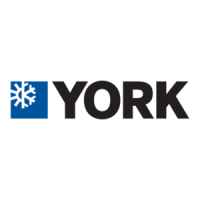YORK INTERNATIONAL
62
PREVENTATIVE MAINTENANCE
It is the responsibility of the owner to provide the neces-
sary daily, monthly and yearly maintenance requirements
of the system. IMPORTANT – If a system failure occurs
due to improper maintenance during the warranty pe-
riod; YORK will not be liable for costs incurred to return
the system to satisfactory operation. The following is in-
tended only as a guide and covers only the chiller unit
components. It does not cover other related system com-
ponents which may or may not be furnished by YORK.
System components should be maintained according to
the individual manufacturers’ recommendations as their
operation will affect the operation and life of the chiller.
DAILY MAINTENANCE
It is recommended that the following items be checked daily.
1. Oil Level – Correct oil level is when oil appears in
either of the compressor oil sight glasses after the
unit has been in operation for about two hours. If it
is necessary to add oil after this operating period,
see item #3 under the ANNUAL MAINTENANCE
section.
2. Oil Pressure – Oil pressure should be a minimum
of 20 PSI above suction pressure.
3. Compressor Superheat – Correct superheat is
10-15°F measured at the compressor.
4. Operating Pressures and Temperatures – Check
to see that operating pressures and temperatures
are within the LIMITATIONS shown in this book.
WEEKLY MAINTENANCE
It is recommended that the following items be checked
weekly.
1. All items listed under DAILY MAINTENANCE.
2. Color of Compressor Oil – New oil is clear, and if
the system is not contaminated with moisture and/
or foreign material, should retain its new appear-
ance for a reasonable length of operating time. Dis-
coloration of the oil, either turning darker brown or
in some cases lighter, is an indication of contamina-
tion, basically due to moisture. If it is necessary to
charge oil refer to item #3 under the ANNUAL MAIN-
TENANCE section.
3. Check the refrigerant circuit for leaks.
ANNUAL MAINTENANCE
It is recommended that the following items be checked
annually.
1. All items listed under WEEKLY MAINTENANCE.
2. Operating Controls – Check to see if controls are
set and operating within the proper limits. See Unit
Controls and OPERATION section of this book.
3. Compressor Oil – Drain, inspect and refill with new
oil. This requires pumping out the compressor. If pos-
sible, this should be done after the unit has been in
operation for some time, when the oil in the crank-
case will contain the least amount of refrigerant. To
pump out the compressor, proceed as follows:
A. Close the suction stop valve.
B. Open the discharge stop valve two turns of the stem.
C. Operate the compressor until 15 to 20 inches
vacuum is obtained. Do this by disconnecting the
wiring to LLSV and repeatedly starting the compres-
sor. Recycle 115VAC power to the Logic Panel to
reduce anti-recycle time to 2 min. if needed. The
compressor should in no case be operated under
vacuum conditions for longer than 10 to 15 seconds.
D. Stop the compressor and immediately close the dis-
charge stop valve. The procedures outlined in steps
(b) and (c) above should be repeated if the suction
pressure rises rapidly to 15 PSIG or more which would
indicate considerable refrigerant remaining in the crank-
case oil. Do not expect to retain 0 PSIG, since some
refrigerant will continually be released from the oil in
the crankcase.
E. After pumping down the compressor, wait until the
pressure builds up to 2 or 3 PSIG before opening up
any part of the hermetic compressor.
F. Open the oil drain valve slowly and drain as much
oil from the compressor as possible.
G. Examine the oil for any metal particles which would
indicate wear on the bearings, crankshaft or connect-
ing rods. If metal particles are found, the need for closer
examination by factory service personnel is indicated.
H. If the oil is clean and free of metal particles, refill the
compressor with YORK oil “C”. To add oil or to fill the
compressor crankcase, connect the delivery tube of
the YORK Hand Oil Pump, YORK Part No. 470-10654
or equal to the compressor oil charging and drain valve.
Expel all air from the delivery tube by pumping it full of
oil, allowing a few drops to drip out before tightening
the flare nut to the oil charging valve. Then open the oil
charging valve and pump oil into the crankcase to the
proper level. It is necessary that the suction end of the
hand oil pump be kept submerged under the oil level
in the container at all times, to avoid entrance of air
into the compressor.
I. Before opening the suction or discharge stop valves,
connect a vacuum pump to the pumpout port in the
discharge stop valve.(Pumpout port is port on valve
stem side of valve.) With the vacuum line shutoff
valve open, run the vacuum pump until a vacuum of
at least 1000 microns is reached. Stop the vacuum
pump, close the shut-off valve and open the dis-
charge valve fully before disconnecting the line from
the vacuum pump. Disconnect the vacuum pump
and replace the plug in the pumpout port.
NOTE: If
suction or discharge valves are not seated properly,
a 1000 micron vacuum can not be obtained. Do not
evacuate for long periods of time.
J. Be sure both discharge and suction stop valves are
open before operating the unit.
4. Suction and Discharge Valves – The condition of
the suction and discharge valves should be checked
by YORK service personnel.
(YCHA120, 150, 175 & 200)

